Check out my youtube channel for a demonstration.
I also put together a webpage describing how an Apple II controls the switches.

Check out my youtube channel for a demonstration.
I also put together a webpage describing how an Apple II controls the switches.
I have just put up a new essay titled Building a Railroad onto my Stories Page. The download is free.
This is an extensively illustrated essay that contains part of a diary kept by John Morgan, assistant engineer for the U.S. Military Railroad at City point during the siege of Petersburg. The period covered is February 5th to March 6th, 1865, when the City Point and Army Line Railroad was expanded to support the new positions of the Army of the Potomac after the Battles of Hatcher’s Run. I have added much commentary about the U.S. Military Railroad and the events that occurred at this time.
One of the things that I looked at when I visited the National Archives a few years ago, was a journal that had daily entries. These entries loosely described what the engineering and construction corps of the USMRR was up to on each day of the Petersburg champaign. I’m not exactly sure who was responsible for making the entries, but there is handwriting from several different people in the journal. Typical entries reported on the weather, what the various construction gangs were up to, significant military and political events and so on. Like most diaries, the content isn’t that exciting, but there are a few gems in there. Here is one of more interesting entries that I encountered.
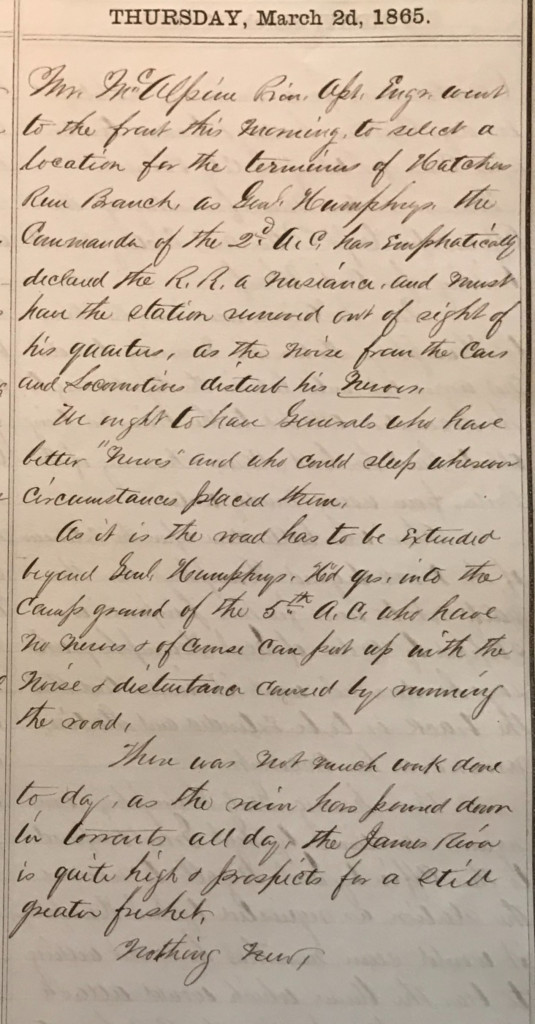
Here is it transcribed.
Thursday March 2d, 1865
Mr McAlpine, Prin. Asst. Engr went to the front this morning to select a location for the terminus of the Hatcher Run Branch as Genl Humphreys, the Commander of the 2nd A.C. has emphatically declared the R.R. a nuisance and must have the station removed out of sight of his quarters, as the noise from the cars and locomotives disturb his nerves.
We ought to have Generals who have better “nerves” and who could sleep wherever circumstances placed them.
As it is the road has to be extended beyond Genl. Humphreys Headquarters into the Campground of the 5th A. C. who have no nerve & of course can put up with the noise & disturbance caused by running the road.
There was not much work done today, as the rain has poured down in torrents all day. The James River is quite high & prospects for a still greater freshet.
Nothing New
There are several remarkable things about this entry.
First of all is the comment about the need for “Generals who have better nerves.” I worked for almost 40 years in various tech jobs for companies big and small. Though it is pretty routine for an individual to complain about a managers decisions, it is extremely rare for anyone to put it down in writing. Usually, that becomes what is known in industry as a career limiting move or a “CLM.” I can only guess that the entry was written either by a civilian employee or someone else that didn’t intend on making the army a career.
The second thing that struck me is how a general might demand that the railroad move it’s terminus so all the activity didn’t disturb his nerves. This caused me to spend some time investigating general A.A. Humphreys to see just what kind of person he was.
What I found was a most interesting man. A graduate of the West Point class of 1831, A.A. Humphreys became a highly respected civil engineer. Before the Civil War, he led the survey that was to plot the route for the first transcontinental railroad. He also started work on a detailed analysis of the Mississippi River that was intended to help the engineers improve navigation. That analysis was published shortly after the war.
Though highly respected, he was apparently very set in his ways and it appears he had few close friends. That he navigated the changes in command of the Army of Potomac with little controversy, is probably a reflection of his independent nature. It appears he had a reasonably good relationship with General Meade, who asked him to be chief of staff of the Army of Potomac after Meade took command. At first Humphreys refused the offer, preferring to remain a division commander. Later on, he was asked again to take the position and accepted. Also, General Abbot, who commanded the siege Artillery at Petersburg worked with Humphreys on the Mississippi River project before and after the war. I wonder if it was Humphreys who recommended that Abbot be put in charge of the siege artillery in front of Petersburg. It is somewhat interesting that with all his knowledge of the Mississippi River, that Humphreys was never sent to assist in the fight on that front.
That an engineer of his esteem would make the USMRR move it’s station because of how it disturbed his nerves is very surprising to me and I believe very reflective of his difficult nature. However, there is the possibility that the engineer Humphreys just didn’t like the location chosen for the station for other reasons than “nerves” and had the USMRR move it to what he considered a better spot.
The American Philosophical Society, which was and is one of America’s leading intellectual societies had a lecture by Hampton L. Carson about Humphreys shortly after his death. This paper described Humphreys as follows.
The life of Andrew Atkinson Humphreys was one of reflection and action, of incident and character. A man of science, a brilliant soldier, an accomplished scholar, a polished gentleman, the lineal descendant of distinguished men, and the inheritor of their talents and virtues, he displayed in every walk of life the highest qualities, and combined the most opposite characteristics. Born to command, he easily attained the front rank in every species of labor which he undertook, yet his modesty was as great, as it was rare. His intercourse with men was graced by a charm of manner, a simplicity of diction, purity of sentiment, a gentle resistlessness of will that armed him with a power which few could oppose with success ; or if, misled by these, they had dared to stir the half-hidden fire of his nature, they would have found him as terrible as Saul. … …he was in public and in private, a man to be feared, to be trusted, to be admired, to be loved ; a man with whom no one could trifle, and whom no one would care to offend.
This picture of him, seems to portray a pretty intense person.
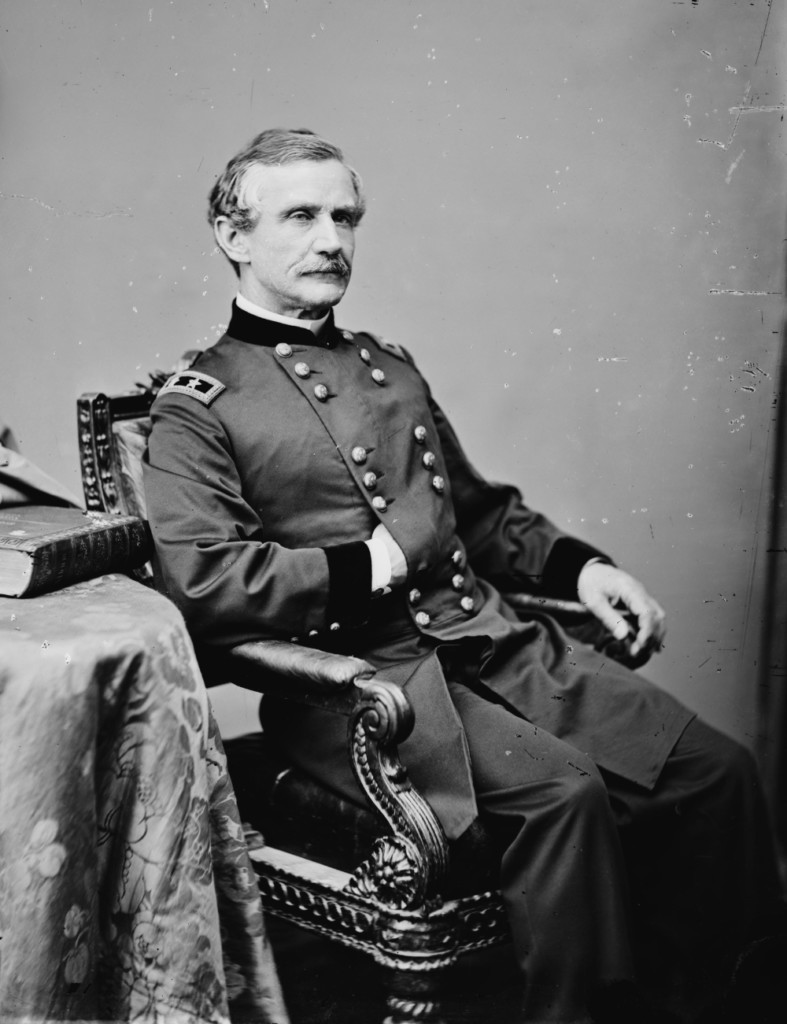
I think this difficult nature also explains how long it took him to attain corps command in the Civil War. However difficult he was, he seemed to know how to defer to superiors, as it seems he was never fired from a job. What do you think about A.A. Humphreys?
I’ve been putting more video’s up on my youtube channel. The latest is a demo of my Macintosh 128K. If you are interested in the history of Macintosh computers, take a look.
I also added a web page with a pretty detailed description of the hardware that I have used to provide automatic locomotive operations.
When I constructed some prototype winter huts for my City Point Model Railroad, I made the assumption that the soldiers used their shelter halves for sides and roofs of the shelters. I cut some paper to the scale size for a shelter half. Like the soldiers would have done, I used these for the roofs and ends of my models. One thing I found is that the shelter halves couldn’t completely cover the ends, so my huts ended up looking like this.
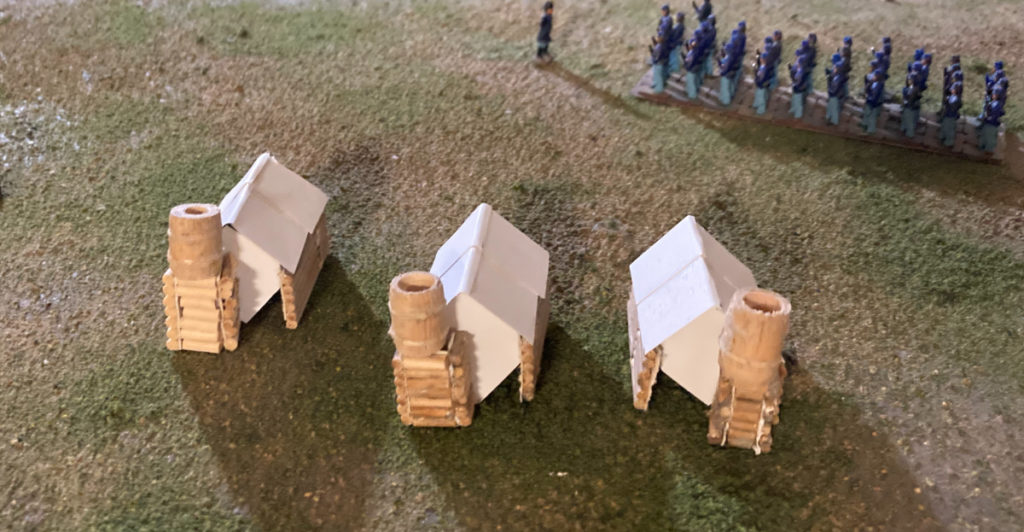
I was looking though some original Civil War images for my City Point Model Railroad and noticed that at least one original hut had the same problem.
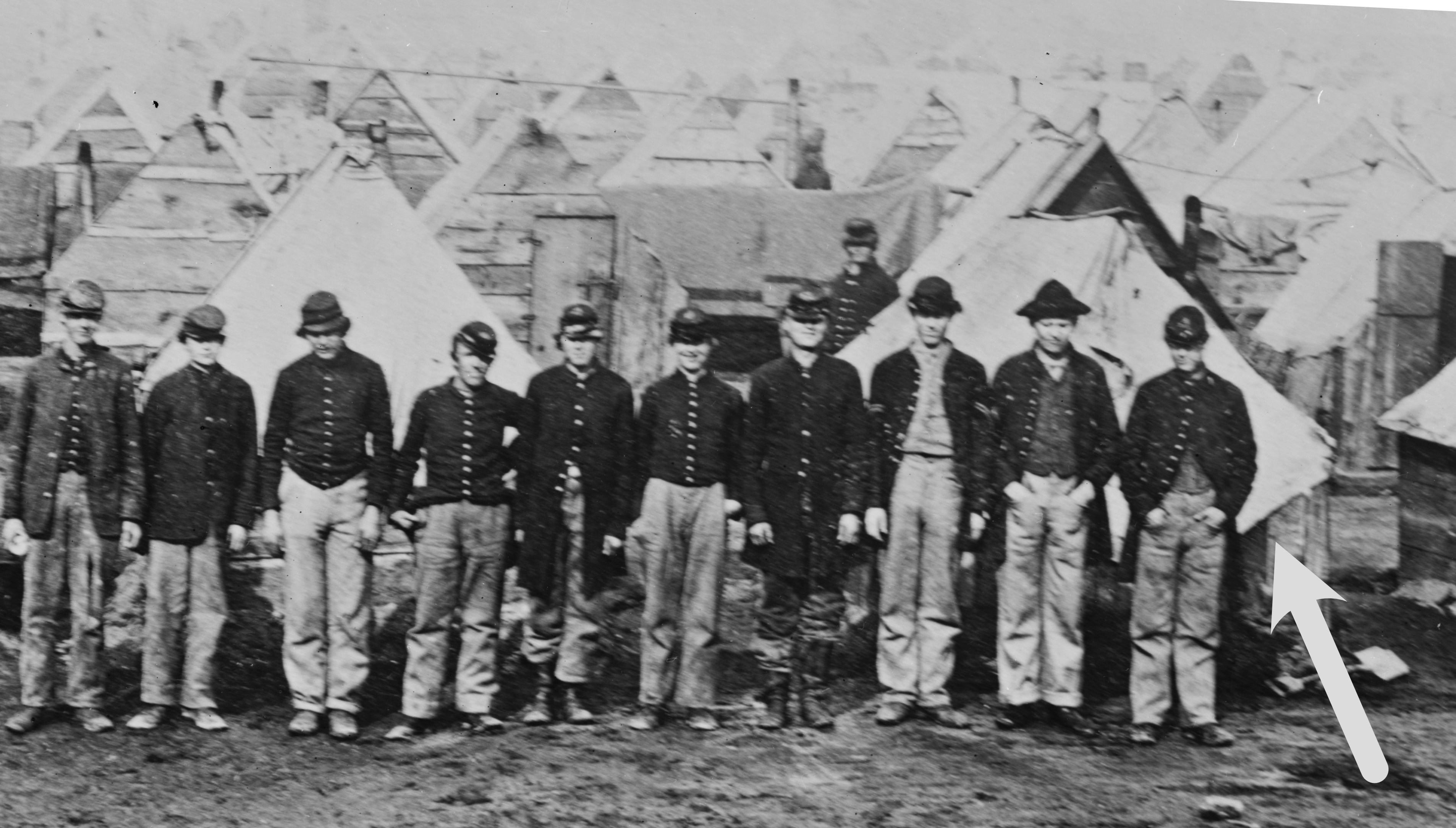
Note how the hut on the right has a shelter half that doesn’t completely cover the end, just like on my model. Looking at this image more closely, it does appear that many of the more enterprising soldiers found enough construction materials to solve this issue. I need many more huts for my layout and will have to build a number of the improved versions.
In 1964, my family went on a 2 week camping trip. We journeyed from Wisconsin to Washington D.C. and back. We visited many sites over the course of those two weeks. The first place we stopped at was Gettysburg National Military Park where I fell off a cannon and developed a life-long interest in the American Civil War. Here is a picture of me on a cannon, just moments before I fell off of it.
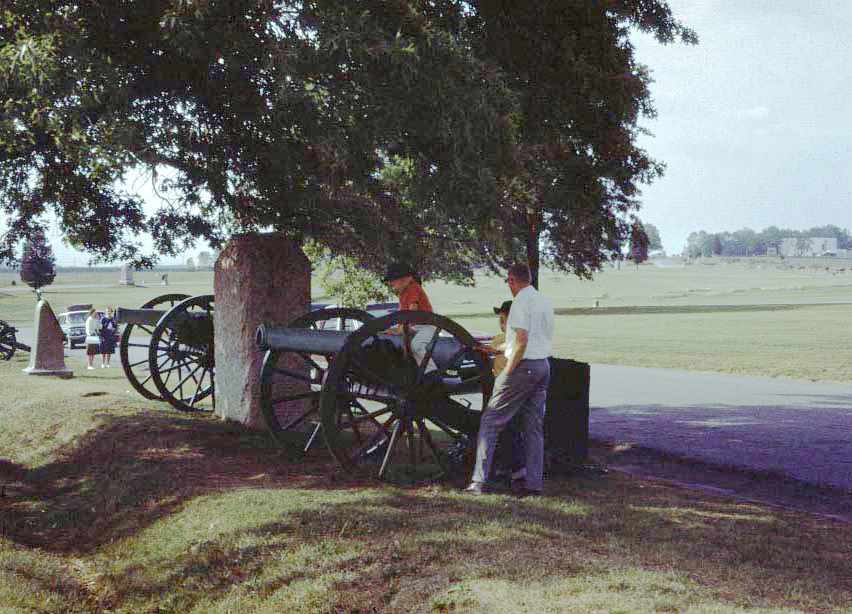
This was taken on Kodachrome slide film with a pretty basic 35mm rangefinder camera. This was a popular way to record vacations back in those days. A few years ago I scanned all the surviving slides from that trip. At the time I scanned those slides, I did some investigation and figured out that the monument next to that cannon, is the monument to Thomas’s Battery, Battery C, of the 4th US Artillery, which was part of the Army of Potomac Artillery Reserve. The key to figuring out where the picture was taken was that there was another picture in this sequence taken of the Pennsylvania Memorial. The Pennsylvania Memorial is just across the road to the right of where this picture was taken.
This summer, as part of a long road trip, I stopped by Gettysburg for a few hours. I decided that I had to stop by the Thomas’s Battery Monument and take another picture. This is how this location looked like in the summer of 2021.
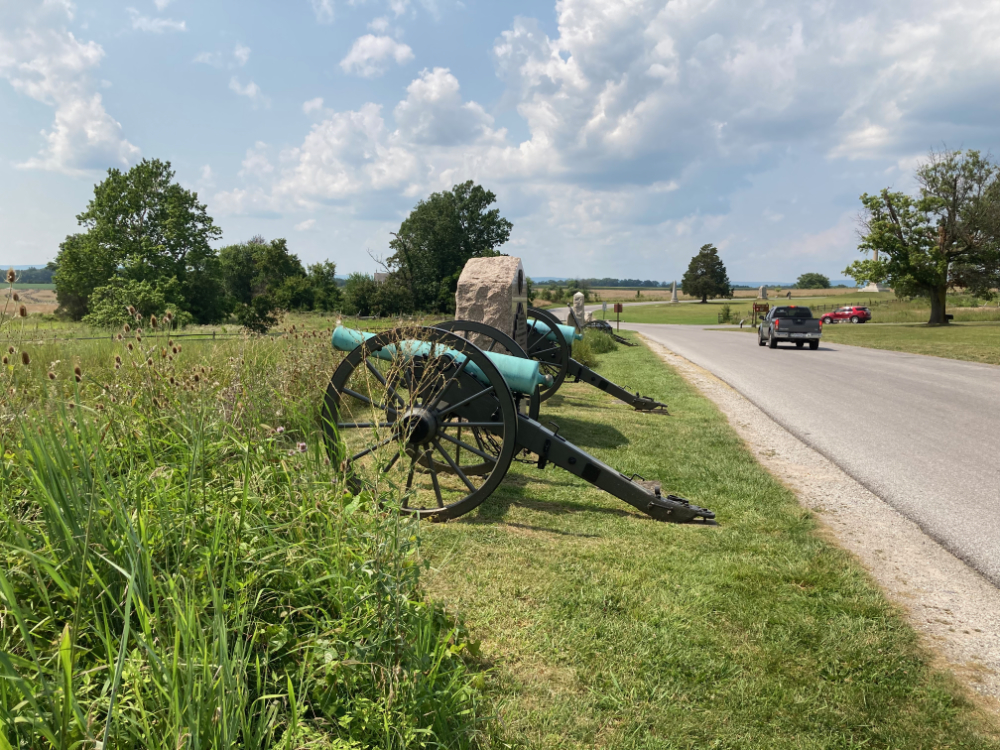
The area in front of the monument isn’t mowed, so I really couldn’t get a picture from the exact same angle, but this gives you an idea how the site looks like these days.
In this previous post, I speculated whether Captain Osborne was the unidentified officer in the group of officers posed with the Dictator mortar. Unfortunately the image of Captain Osborne was later in life and it was a bit hard to make a solid call. Recently, Susan, from the Osbornedate State Park sent me a wartime picture of W.F. Osborne. This picture sheds more light on the issue.
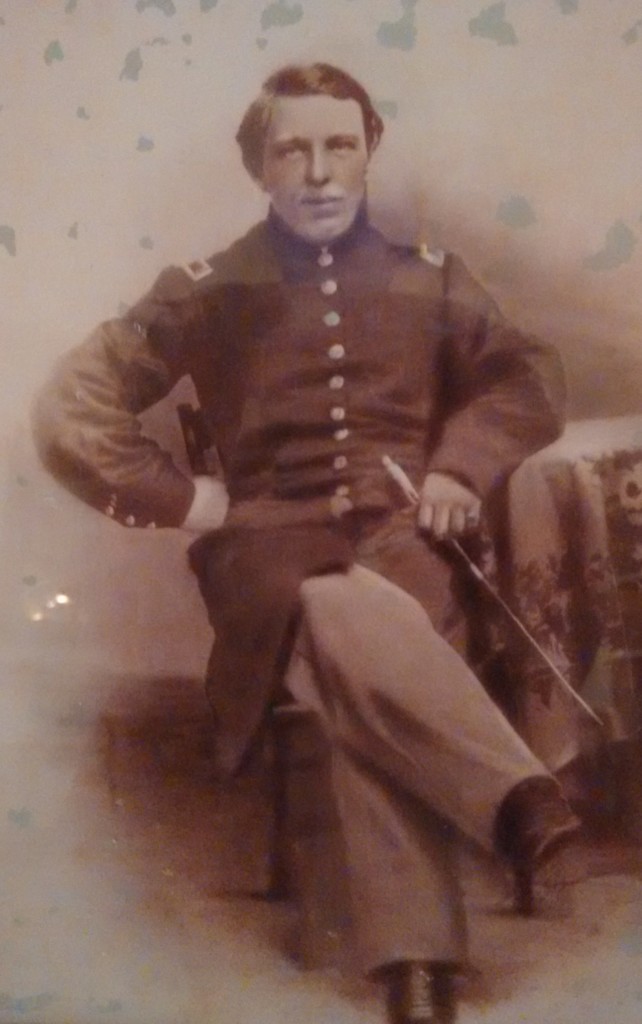
Based on this image, it doesn’t appear that Captain Osborne is the unidentified officer in the Dictator picture.
if you haven’t already, read this post about General Grant’s annoyance with a poorly constructed “tank”.
The post implies that General Grant appears to have little patience with this seemingly small matter. I was recently reviewing that letter and it occurred to me that a couple of contributing factors might have been at play at this point in time. The key thing that I realized is that the date on the memo is March 27, 1865. Two things were going on around this time that might have shortened Grants temper.
So isn’t it just possible that the sharp memo about the lousy tank might have been at least party caused by a recent increase in stress levels that General Grant was subjected to? So the question is, is this annoyance of Grants a normal thing, or was it at least partly due to the stress he was dealing with at that particular moment in time? I can almost imagine Grant flying off the handle after Lincoln tries to use the water tank and finds it broken. Grant vents the frustration of past days on to poor Caption Schummaker who happened to be in the area at the time. Captain Schummaker responds by writing the memo that I found in National Archives.
Here is an image of part of the 1st Connecticut Artillery Regiment in Fort Richardson, a fort that protected Washington D. C. during the Civil War. This is a crop of an image that was probably taken in the winter of 1862, shortly after the conversion of this unit from infantry to artillery, and prior to the unit experiencing any combat. Note the spiffy uniforms and very military appearance of these men. Note the short swords and epaulettes. I think it makes for a very impressive display.
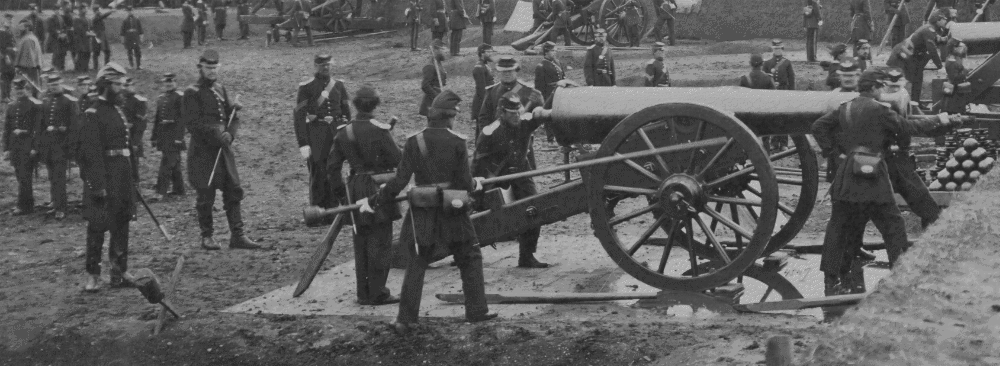
Here is another image showing men of the 1st Connecticut Artillery. In this case, the men are manning the famous 13″ mortar, Dictator, in front of Petersburg. This image was taken in the late summer of 1864.
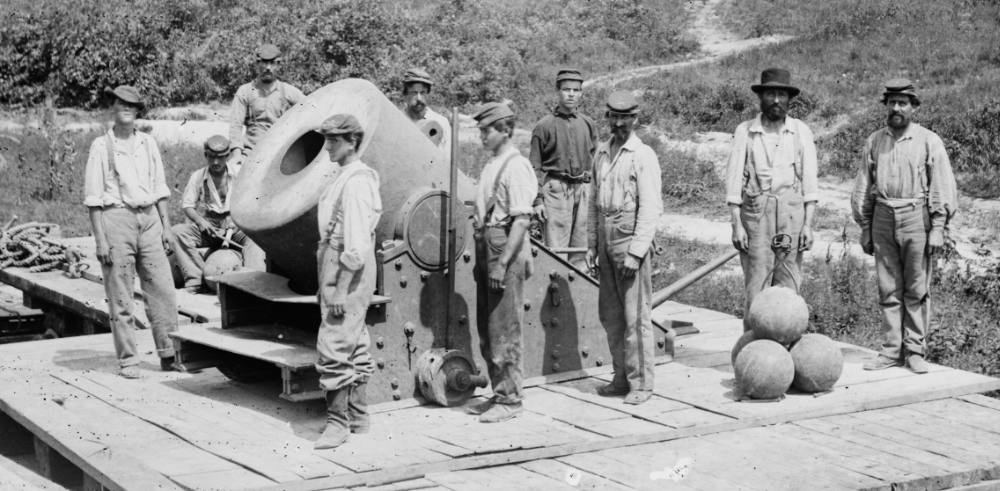
What made me want to share these two images is the vast difference in appearance in the men between these two images. In the second image, the men assume a very casual appearance. Their dress is haphazard, with an assortment of hats and the frock coats have been completely dispensed with. What is more apparent is the lack of military bearing. They look to me exactly like a work crew at a construction site.
According to the regimental history of the 1st Connecticut, the regiment was initially sworn into US service on May 22nd, 1861 for three years service. The enlistments of the original men of this regiment were already up by the time of the second image. There is a note in the regimental history reporting that 400 men were to go home in May, 1864, well before this picture was taken. There were a number of new replacements in the regiment. Somehow, by now, the regiment was 1700 men strong, which was bigger than many infantry brigades from this time. The history contains a complete roster including enlistment and discharge dates for each soldier. I’m thinking about doing an analysis of company G, the company that manned the dictator to find out how the size and composition of the unit changed over time.
As pointed out in a previous post, a number of the officers of the 1st Connecticut, went home in late October and early November. I can’t find any indication of why the captains stayed on until fall.
Is the second image…
I did find one hint in the history. That was a set of instructions that Colonel Tyler gave shortly after arriving on the peninsula in April of 1862. It says
The light blue pants will be packed in the knapsacks, and the old ones worn on the march.
That is all that I have on this topic at the moment. Any thoughts?
In a previous post, I show a picture of the artillery officers examining the Dictator in the summer of 1864. All of the officers in the photograph were identified, in the book, “The photographic History of the Civil War,” except one. Since the Captain Osborne, who was in command of the Dictator was not among those identified, I guessed that the unidentified officer might be him.
I did a little more investigation and was surprised to find that after the war, Captain Osborne became a significant figure in the community of Derby, Connecticut. One of his great achievements was the establishment Derby Neck Library. The establishment of this library included a donation from non other than Andrew Carnegie. Captain Osborne must have been some kind of mover and shaker in order to solicit a donation from such a significant figure.
Captain Osborne’s daughter, Mrs. Frances Osborne Kellogg, took over the family business when he died in 1907. She expanded the successful businesses and accumulated additional property. She had no children, and outlived her husband. When she died, she arranged that the 350 acre property was given to the state, and it has become Osbornedale State Park. The house they both lived in is open to tours. Captain Osborne’s obituary makes for some interesting reading. It can be found at the Derby Historical Society Website
.
The kind people at the park answered an inquiry of mine and provided a picture of Captain Osborne taken later in life. I have used a photo editing application to put the photo they sent me with an enlargement of the original photo of the officers at the dictator.
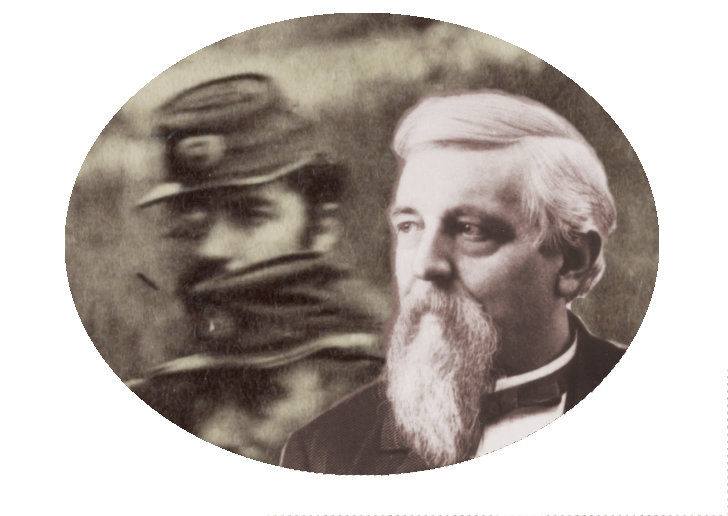
I can’t say for sure whether the two individuals are the same, but I would say that there is a good resemblance. What are your thoughts?
One last thing, Derby, Connecticut, is really close to Milford, Connecticut, where the SCELBI computer was developed. In fact, at one point, Terri Wadsworth taught at Derby High School. Sometimes, it’s a really small world.